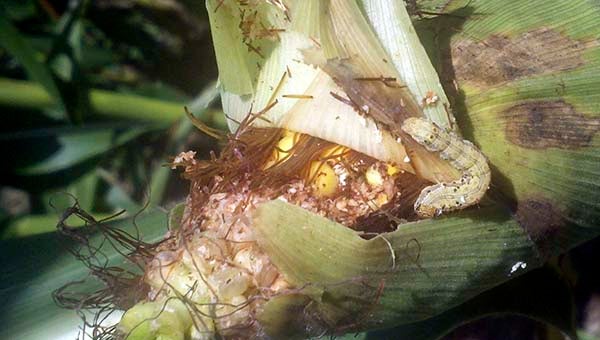Western Tidewater hotspot for corn earworm
Published 9:46 am Wednesday, August 6, 2014

Corn earworms are also known as cotton bollworms, soybean podworms and tomato fruitworms. These pests first feed on corn before multiplying and moving on to damage other crops, such as soybeans, peanuts and cotton. Western Tidewater is at high risk for infestation. — SUBMITTED | NEIL CLARK
SEAN MALONE and NEIL CLARK
I remember as a child, going to the A&P to pick out ears of corn. You would have to shuck them back a few inches to check for worms or worm damage on the tips of the ears. Not that this would really be too significant as less than 10 percent of the ear would be affected. Just snap off the end and you were good to go.
However, long gone are the days that folk expect or tolerate seeing any sort of bug in their produce. Of course, most corn that is grown is not sold as whole ears for fresh consumption, and most ears consumed for this purpose are either harvested before or treated for these pests.
Every year, Virginia Extension specialists and agents conduct a survey to estimate corn earworm infestation levels in field corn. Corn earworm, Helicoverpa zea, also known as cotton bollworms, soybean podworms, tomato fruitworms, etc., are generalist feeders that attack at least 16 cultivated, and over 100 wild, host plants. Corn serves as a nursery crop, where populations build before moving on to other crops such as soybean, cotton, and peanut in August, where their economic damage potential can be much more severe. Depending on attack timing and severity, soybean losses can be substantial. Over 30 years of data show that there is a linear correlation between the infestation level in corn and the amount of soybean acreage that gets treated for this pest. Due to the spotty nature of insect populations, and the vast array of factors which may affect their numbers, we always recommend scouting individual fields to determine threshold levels of pests. Extension offers the corn earworm economic threshold calculator where numbers of caterpillars per sample are determined by inputting the price of beans, control costs, row width and sampling method.
In each of the 29 counties sampled, 10 randomly selected ears in five different locations in each field are examined for the presence of, or damage from, corn earworm larvae. Across the region this year 7,250 ears within 145 fields were sampled. Age of corn earworms, or if they had already exited the ears, was also recorded.
Statewide, approximately 20 percent of ears were infested with corn earworm. For comparison, 18 percent of ears were infested in 2013; 30 percent in 2012; 33 percent in 2011; 40 percent in 2010; and 36 percent in 2009. Regional averages for 2014 were 6 percent infested ears in Northern counties; 4 percent in the Northern Neck; 18 percent in Mid-Eastern; 17 percent in South-Central; 30 percent in the Southeast; and 17 percent on the Eastern Shore.
Corn earworm produces two to three generations per year. And it is not this current generation that is the concern economically, as much as future generations which may affect later developing crops, such as soybeans that are planted on extensive acreage this year.
To further track and more fine tune our predictions of population severity, we also monitor corn earworm moth flights with black light traps and report those results weekly. Though this gives us additional information about population estimates, it more importantly gives us information on timing of the next population boom, so that our in field sampling of soybean using sweep nets and our timing of treatments is most effective. The corn earworm population is very slow to develop this year. We are only getting a couple of moths each night in our black light traps and are way down compared to this time last year. However, with those numbers in local fields it is a matter of time before they emerge and begin mating and producing the next generation, which will begin feeding on bean, cotton, peanut and other crops. Extension will try to keep growers abreast of what is going on with these populations and optimal treatment timing and regimes.
In related news, we have documented Southampton County’s first instance of brown marmorated stink bug, Halyomorpha halys. This inauspicious event is hardly a reason to celebrate. Let’s hope the numbers stay low and it doesn’t prove out to be another expense in the treatment column.
SEAN MALONE is a research specialist at the Tidewater Agricultural Research and Extension Center. He can be contacted at 657-6450 or smalone@vt.edu
NEIL CLARK is the Extension Agent, ANR, Southeast District Forestry and Southampton UC. He can be contacted at 653-2572 or southeast@vt.edu





